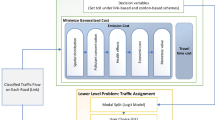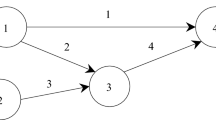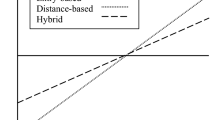Abstract
Congestion pricing is an important component of urban intelligent transport system. The efficiency, equity and the environmental impacts associated with road pricing schemes are key issues that should be considered before such schemes are implemented. This paper focuses on the cordon-based pricing with distance tolls, where the tolls are determined by a nonlinear function of a vehicles’ travel distance within a cordon, termed as toll charge function. The optimal tolls can give rise to: 1) higher total social benefits, 2) better levels of equity, and 3) reduced environmental impacts (e.g., less emission). Firstly, a deterministic equilibrium (DUE) model with elastic demand is presented to evaluate any given toll charge function. The distance tolls are non-additive, thus a modified path-based gradient projection algorithm is developed to solve the DUE model. Then, to quantitatively measure the equity level of each toll charge function, the Gini coefficient is adopted to measure the equity level of the flows in the entire transport network based on equilibrium flows. The total emission level is used to reflect the impacts of distance tolls on the environment. With these two indexes/measurements for the efficiency, equity and environmental issues as well as the DUE model, a multi-objective bi-level programming model is then developed to determine optimal distance tolls. The multi-objective model is converted to a single level model using the goal programming. A genetic algorithm (GA) is adopted to determine solutions. Finally, a numerical example is presented to verify the methodology.
Similar content being viewed by others
References
MAY A D, LIU R, SHEPHERD S P, SUMALEE A. The impact of cordon design on the performance of road pricing schemes [J]. Transport Policy, 2002, 9(3): 209–220.
HO H W, WONG S C, YANG H, LOO B P Y. Cordon-based congestion pricing in a continuum traffic equilibrium system [J]. Transportation Research Part A: Policy and Practice, 2005, 39(7): 813–834.
LIU Zhi-yuan, WANG Shuai-an, MENG Qiang. Toll pricing framework under logit-based stochastic user equilibrium constraints [J]. Journal of Advanced Transportation, 2013, 48(8): 1121–1137.
LIU Zhi-yuan, WANG Shuai-an, MENG Qiang. Optimal joint distance and time toll for cordon-based congestion pricing [J]. Transportation Research Part B: Methodological, 2014, 69: 81–97.
LIU Zhi-yuan, MENG Qiang, WANG Shuai-an. Speed-based toll design for cordon-based congestion pricing scheme [J]. Transportation Research Part C: Emerging Technologies, 2013, 31(2): 83–98.
LIU Zhi-yuan, MENG Qiang. Bus-based park-and-ride system: a stochastic model on multimodal network with congestion pricing schemes [J]. International Journal of Systems Science, 2014, 45(5): 994–1006.
MENG Qiang, LIU Zhi-yuan, WANG Shuai-an. Optimal distance tolls under congestion pricing and continuously distributed value of time [J]. Transportation Research Part E: Logistics and Transportation Review, 2012, 48(5): 937–957.
MAY A D, MILNE D S. Effects of alternative road pricing systems on network performance [J]. Transportation Research Part A: Policy and Practice, 2000, 34(6): 407–436.
JOU R C, CHIOU Y C, CHEN K H, TAN H I. Freeway drivers’ willingness-to-pay for a distance-based toll rate [J]. Transportation Research Part A: Policy and Practice, 2012, 46(3): 549–559.
LAWPHONGPANICH S, YIN Y. Nonlinear pricing on transportation networks [J]. Transportation Research Part C: Emerging Technologies, 2012, 20(1): 218–235.
MENG Qiang, LIU Zhi-yuan. Impact analysis of cordon-based congestion pricing on mode-split for a bimodal transportation network [J]. Transportation Research Part C: Emerging Technologies, 2012, 21(1): 134–147.
JOU R C, YEH Y C. Freeway passenger car drivers’ travel choice behaviour in a distance-based toll system [J]. Transport Policy, 2013, 27: 11–19.
YANG Hai, HUANG Hai-jun. Mathematical and economic theory of road pricing [M]. Elsever, 2005.
SANTOS G. The London congestion charging scheme [M]// RICHARDSON H W, BAE C H C. Chapter 8: Road congestion pricing in Europe—Implications for the United States. Edward Elgar Publishing, 2008: 159–175.
MENG Qiang, YANG Hai. Benefit distribution and equity in road network design [J]. Transportation Research Part B: Methodological, 2002, 36(1): 19–35.
YANG Hai, ZHANG Xiao-ning. Multiclass network toll design problem with social and spatial equity constraints [J]. Journal of Transportation Engineering, 2002, 128(5): 420–428.
SUMALEE A, MAY T, SHEPHERD S. Comparison of judgmental and optimal road pricing cordons [J]. Transport Policy, 2005, 12(5): 384–390.
MARUYAMA T, SUMALEE A. Efficiency and equity comparison of cordon and area-based road pricing schemes using a trip-chain equilibrium model [J]. Transportation Research Part A: Policy and Practice, 2007, 41(7): 655–671.
YIN Y. Multiobjective bilevel optimization for transportation planning and management problems [J]. Journal of Advanced Transportation, 2002, 36(1): 93–105.
CHEN A, SUBPRASOM K, JI Z. A simulation-based multi-objective genetic algorithm (SMOGA) procedure for BOT network design problem [J]. Optimization and Engineering, 2006, 7(3): 225–247.
SHARMA S, MATHEW T V. Multiobjective network design for emission and travel-time trade-off for a sustainable large urban transportation network [J]. Environment and Planning B: Planning and Design, 2011, 38(3): 520–538.
CHEN A, XU X D. Goal programming approach to solve the stochastic multi-objective network design problem [M]. Network Reliability in Practice. New York: Springer, 2012: 151–170.
YIN Y, LI Z C, LAM W H K, CHOI K. Sustainable toll pricing and capacity investment in a congested road network: A goal programming approach [J]. Journal of Transportation Engineering, 2014, 140(12): 04014062.
WANG Shuai-an, MENG Qiang, YANG Hai. Global optimization methods for the discrete network design problem [J]. Transportation Research Part B: Methodological, 2013, 50(4): 42–60.
SHEFFI Y. Urban transportation networks: Equilibrium analysis with mathematical programming methods [M]. Prentice-Hall, 1985.
JAYAKRISHNAN R, TSAI W T, PRASHKER J N, RAJADHYAKSHA S. A faster path-based algorithm for traffic assignment [J]. Transportation Research Reord, 1994, 1443: 75–83.
CHEN A, JAYAKRISHNAN R. A path-based gradient projection algorithm: effects of equilibration with a restricted path set under two flow update policies [M]. Irvine: University of California, 1998.
DIAL R B. A path-based user-equilibrium traffic assignment algorithm that obviates path storage and enumeration [J]. Transportation Research Part B: Methodological, 2006, 40(10): 917–936.
LO H K, CHEN A. Traffic equilibrium problem with route-specific costs: formulation and algorithms [J]. Transportation Research Part B: Methodological, 2000, 34(6): 493–513.
CHEN A, ZHOU Z, XU X. A self-adaptive gradient projection algorithm for the nonadditive traffic equilibrium problem [J]. Computers & Operations Research, 2012, 39(2): 127–138.
CHENG L, IIDA Y, UNO N, WANG W. Alternative quasi-newton methods for capacitated user equilibrium assignment [J]. Transportation Research Record, 2003, 1857: 109–116.
SHARMA S, MISHRA S. Intelligent transportation systems-enabled optimal emission pricing models for reducing carbon footprints in a bimodal network [J]. Journal of Intelligent Transportation Systems, 2013, 17(1): 54–64.
WALLACE C E, COURAGE K, REAVES D, SCHOENE G, EULER G. TRANSYT-7F user's manual [M]. Gainesville: University of Florida, 1984.
SHEPHERD S, SUMALEE A. A genetic algorithm based approach to optimal toll level and location problems [J]. Networks and Spatial Economics, 2004, 4(2): 161–179.
YANG Hai, ZHANG Xiao-ning, MENG Qiang. Modeling private highways in networks with entry–exit based toll charges [J]. Transportation Research Part B: Methodological, 2004, 38(3): 191–213.
Author information
Authors and Affiliations
Corresponding author
Additional information
Foundation item: Projects(61304198, 61374195) supported by the National Natural Science Foundation of China; Projects(2013M530159, 2014T70351) supported by the China Postdoctoral Science Foundation
Rights and permissions
About this article
Cite this article
Sun, X., Liu, Zy., Thompson, R.G. et al. A multi-objective model for cordon-based congestion pricing schemes with nonlinear distance tolls. J. Cent. South Univ. 23, 1273–1282 (2016). https://doi.org/10.1007/s11771-016-0377-4
Received:
Accepted:
Published:
Issue Date:
DOI: https://doi.org/10.1007/s11771-016-0377-4




